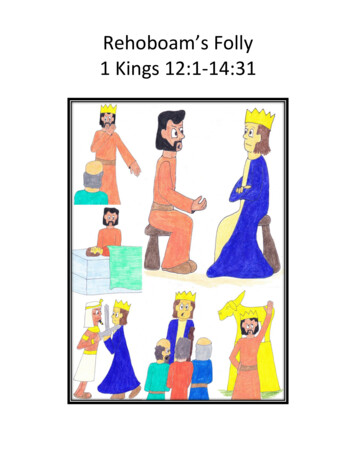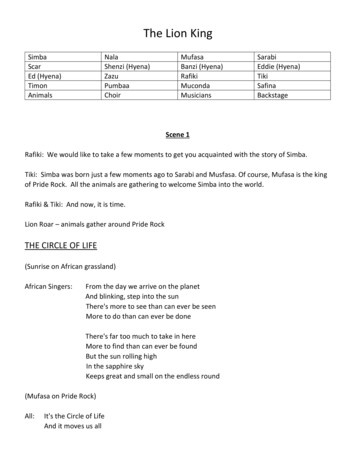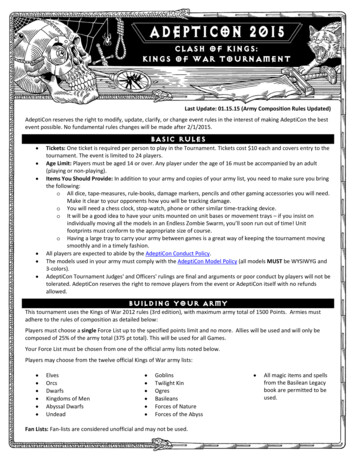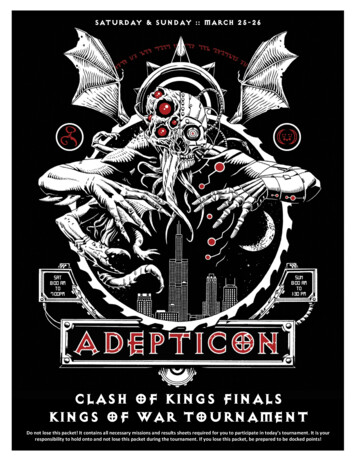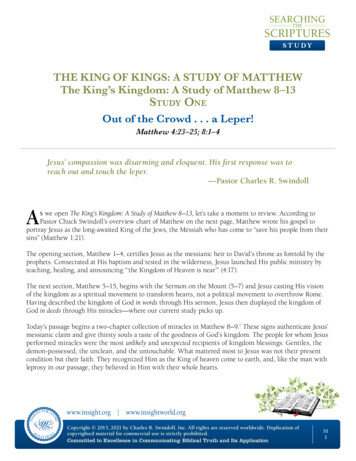
Transcription
ST U DYTHE KING OF KINGS: A STUDY OF MATTHEWThe King’s Kingdom: A Study of Matthew 8–13Study OneOut of the Crowd . . . a Leper!Matthew 4:23–25; 8:1–4Jesus’ compassion was disarming and eloquent. His first response was toreach out and touch the leper.—Pastor Charles R. SwindollAwe open The King’s Kingdom: A Study of Matthew 8–13, let’s take a moment to review. According toPastor Chuck Swindoll’s overview chart of Matthew on the next page, Matthew wrote his gospel toportray Jesus as the long-awaited King of the Jews, the Messiah who has come to “save his people from theirsins” (Matthew 1:21).sThe opening section, Matthew 1–4, certifies Jesus as the messianic heir to David’s throne as foretold by theprophets. Consecrated at His baptism and tested in the wilderness, Jesus launched His public ministry byteaching, healing, and announcing “‘the Kingdom of Heaven is near’” (4:17).The next section, Matthew 5–15, begins with the Sermon on the Mount (5–7) and Jesus casting His visionof the kingdom as a spiritual movement to transform hearts, not a political movement to overthrow Rome.Having described the kingdom of God in words through His sermon, Jesus then displayed the kingdom ofGod in deeds through His miracles—where our current study picks up.Today’s passage begins a two-chapter collection of miracles in Matthew 8–9.1 These signs authenticate Jesus’messianic claim and give thirsty souls a taste of the goodness of God’s kingdom. The people for whom Jesusperformed miracles were the most unlikely and unexpected recipients of kingdom blessings: Gentiles, thedemon-possessed, the unclean, and the untouchable. What mattered most to Jesus was not their presentcondition but their faith. They recognized Him as the King of heaven come to earth, and, like the man withleprosy in our passage, they believed in Him with their whole hearts.www.insight.org www.insightworld.orgCopyright 2015, 2021 by Charles R. Swindoll, Inc. All rights are reserved worldwide. Duplication ofcopyrighted material for commercial use is strictly prohibited.Committed to Excellence in Communicating Biblical Truth and Its ApplicationS11
THE KING OF KINGS: A STUDY OF MATTHEWThe King’s Kingdom: A Study of Matthew 8–13Study OneST U DYOut of the Crowd . . . a Leper!Matthew 4:23–25; 8:1–4MATTHEWAnnouncementand Arrivalof the KingMain Emphasis:His CredentialsMain Emphasis:His MessageBirthBaptismTemptationCHAPTERS1–4The KingScopeLocationPeople’s ReactionThemeProclamationand Receptionof the KingResurrectionand Triumphof the KingMain Emphasis: HisSuffering and DeathMain Emphasis:His ConquestSermon on the MountSpread of oppositionGod’s powerMiraclesPreparation of disciplesGreat CommissionDiscoursesFinal RS16–27CHAPTER28His identity: Israel’s promised KingHis destiny: “Crucify Him!”Teaching the vast multitudesTeaching the TwelveBethlehem and NazarethMinistry in GalileeIncreased popularityMinistry in JudeaIncreased hostilityJesus is the King, Israel’s long-awaited Messiah.16:16–19; 28:18–20Key VersesChrist in MatthewOppositionand Rejectionof the KingJesus, the Messiah, fulfills the prophecies, promises, types, and expectations of theOld Testament Scriptures (16:16–19; 28:18–20).Copyright 1982, 1997, 2010 by Charles R. Swindoll, Inc. All rights reserved worldwide.PREPARE YOUR HEARTAs you open the Word, come to Jesus as the leprous man, with hands outstretched to receive the Lord’scompassion.Father, I bring to You my need. See me for who I am and take pity on me, just as Your Son took pityon the humble man with leprosy. As I open the Scriptures, I also open my heart to You and Yourcleansing touch. In Jesus’ name, amen.Copyright 2015, 2021 by Charles R. Swindoll, Inc. All rights are reserved worldwide. Duplication ofcopyrighted material for commercial use is strictly prohibited.Committed to Excellence in Communicating Biblical Truth and Its ApplicationS12
THE KING OF KINGS: A STUDY OF MATTHEWThe King’s Kingdom: A Study of Matthew 8–13Study OneOut of the Crowd . . . a Leper!ST U DYMatthew 4:23–25; 8:1–4TURN TO THE SCRIPTURESThe closing verses of chapter 4 and the opening verses of Matthew 8 bookend the Sermon on the Mount.Read Matthew 4:23–25 and 8:1–4, and write down what ties these passages together.The same Greek phrase for “large crowd” appears in 4:25 and 8:1, indicating not just a single group butmany groups of people from all over the region—all needy, all seeking help. Out of these crowds, theafflicted man came alone to Jesus, parting the sea of people who drew back at the dreadful sight of him. Let’slook closer at this man’s terrible disease, his humble heart of faith, and Jesus’ remarkable act of compassion.Observation: Encountering a Man with LeprosyIn the Searching the Scriptures method of Bible study, we first observe the passage by reading carefully andslowly, absorbing every word.2Searching the Scriptures Study ToolJust as we need tools in the kitchen to help us cook our meals, we need Bible study tools to helpus feed ourselves God’s Word. An essential tool for our studies is Pastor Chuck’s two-volumecommentary, Insights on Matthew 1–15 and Insights on Matthew 16–28.3 For background study, werecommend a Bible dictionary, such as The New Unger’s Bible Dictionary.The Man’s Condition and Action—Matthew 8:2aKnown today as Hansen’s disease, leprosy deadens nerve endings causing sufferers to unknowingly injurethemselves. Years of untreated wounds, infections, and ulcerations lead to loss of limbs and irreversibledecay. “It is a kind of terrible progressive death in which a man dies by inches.” 4Copyright 2015, 2021 by Charles R. Swindoll, Inc. All rights are reserved worldwide. Duplication ofcopyrighted material for commercial use is strictly prohibited.Committed to Excellence in Communicating Biblical Truth and Its ApplicationS13
THE KING OF KINGS: A STUDY OF MATTHEWThe King’s Kingdom: A Study of Matthew 8–13Study OneOut of the Crowd . . . a Leper!ST U DYMatthew 4:23–25; 8:1–4Use your resources to research leprosy in Bible times. Read the inset article, “Leprosy,” on page 145 of PastorChuck Swindoll’s commentary, Insights on Matthew 1–15. What do you discover?The physical suffering was severe, but the misery of isolation was worse. According to commentator WilliamBarclay,Lepers were treated “as if they were, in effect, dead men.” Immediately [when] leprosy wasdiagnosed, the leper was absolutely and completely banished from human society. . . . Theleper had to go with rent clothes, disheveled hair, with a covering upon his upper lip, and, ashe went, he had to cry: “Unclean, unclean” (Leviticus 13:45).5Try to imagine this man with leprosy making his way to Jesus. What physical, religious, and socialobstacles would he have had to overcome? What news might he have heard about Jesus that filled him withdetermination? What actions showed he understood who Jesus was?Copyright 2015, 2021 by Charles R. Swindoll, Inc. All rights are reserved worldwide. Duplication ofcopyrighted material for commercial use is strictly prohibited.Committed to Excellence in Communicating Biblical Truth and Its ApplicationS14
THE KING OF KINGS: A STUDY OF MATTHEWThe King’s Kingdom: A Study of Matthew 8–13Study OneOut of the Crowd . . . a Leper!ST U DYMatthew 4:23–25; 8:1–4The Man’s Humble Faith—Matthew 8:2bObserve carefully the man’s statement: “‘Lord . . . if you are willing, you can heal me and make me clean’”(Matthew 8:2). What do you see? What part of this passage reveals his faith?The Greek construction of the conditional phrase, “if you are willing,” suggests that the Lord may or maynot have been willing to help. And the man held no expectations. No presumptions, no bargaining. He trulybelieved Jesus could make him whole, but he never assumed that Jesus would. What does the man’s approachsay about his humble heart?The Lord’s Compassionate Response—Matthew 8:3–4What did Jesus do that no other rabbi would have done (Matthew 8:3)? Also, what did Jesus do that only Hecould do?Copyright 2015, 2021 by Charles R. Swindoll, Inc. All rights are reserved worldwide. Duplication ofcopyrighted material for commercial use is strictly prohibited.Committed to Excellence in Communicating Biblical Truth and Its ApplicationS15
THE KING OF KINGS: A STUDY OF MATTHEWThe King’s Kingdom: A Study of Matthew 8–13Study OneOut of the Crowd . . . a Leper!ST U DYMatthew 4:23–25; 8:1–4What do you think Jesus communicated to the man and the crowd by touching the leprous man? In addition,what two attributes of His nature did Jesus convey by saying, “‘I am willing’” and “‘Be healed!’” (Matthew 8:3)?The sores fell away in the moment it takes to wash dirt from our arms. The man must have cried out withjoy, but the Lord put a finger to His lips. How did Jesus’ instructions show respect for God’s law (8:4)?Why did Jesus say to the man not to tell anyone? Because He was the Messiah, and thetiming had to be just right for His plan. People would want to make Him their king based onHis power to heal. His ministry was not only to heal but transform lives.—Pastor Chuck SwindollInterpretation: Our Savior’s Response to FaithIn the interpretation phase of Searching the Scriptures, we examine the meaning of the passage. Byincluding this account of Jesus cleansing the man of leprosy, Matthew intended his original readers tolearn certain truths.Copyright 2015, 2021 by Charles R. Swindoll, Inc. All rights are reserved worldwide. Duplication ofcopyrighted material for commercial use is strictly prohibited.Committed to Excellence in Communicating Biblical Truth and Its ApplicationS16
THE KING OF KINGS: A STUDY OF MATTHEWThe King’s Kingdom: A Study of Matthew 8–13Study OneOut of the Crowd . . . a Leper!ST U DYMatthew 4:23–25; 8:1–4What do we learn about the person of Jesus? For insight, consult Pastor Chuck’s, Insights on Matthew 1–15,pages 144–45.What do we learn from the example of the man’s faith and approach to Jesus?Matthew didn’t use the Greek word for “heal” in reference to leprosy, rather, katharizō, which means“cleanse.” Read Matthew 10:7–8 and 11:4–5 in the New American Standard Bible to see how the word cleansedis used specifically with leprosy.Leprosy is often compared to sin in Scripture, and just as Jesus cleansed the man of His leprosy, “the bloodof Jesus . . . cleanses us from all sin” (1 John 1:7). Let’s look deeper into this connection between cleansingof leprosy and cleansing of sin.Correlation: The Contrite Heart and Cleansing of SinBy correlating our passage with similar passages, we can confirm our interpretation and gain a broaderunderstanding of God’s Word. Jesus told the cleansed man to go to the priest for ceremonial purification, inaccordance with the protocols of the Mosaic law.Copyright 2015, 2021 by Charles R. Swindoll, Inc. All rights are reserved worldwide. Duplication ofcopyrighted material for commercial use is strictly prohibited.Committed to Excellence in Communicating Biblical Truth and Its ApplicationS17
THE KING OF KINGS: A STUDY OF MATTHEWThe King’s Kingdom: A Study of Matthew 8–13Study OneOut of the Crowd . . . a Leper!ST U DYMatthew 4:23–25; 8:1–4Leviticus 14:1–9 describes the process for ceremonial purification for the people of Israel, and 14:10–32outlines the intricate details for making offerings to the Lord. Scan these complex requirements to get anidea of what was required for purification. And then, against this backdrop, read David’s psalm of contritionand plea for God to cleanse him from his sin in Psalm 51.What does 51:1–2, 7–10 say about how God cleanses us?What does God desire from us when we sin, according to 51:16–17?As David declared, God will never “reject a broken and repentant heart” (Psalm 51:17)!What makes a contrite heart such a beautiful sacrifice to God? It makes no demands.It nurses no blame or grudges. It entertains no expectations. It offers no conditions. Itanticipates no favors. It is the attitude God loves! And that’s the attitude of the leprousman. —Pastor Chuck SwindollCopyright 2015, 2021 by Charles R. Swindoll, Inc. All rights are reserved worldwide. Duplication ofcopyrighted material for commercial use is strictly prohibited.Committed to Excellence in Communicating Biblical Truth and Its ApplicationS18
THE KING OF KINGS: A STUDY OF MATTHEWThe King’s Kingdom: A Study of Matthew 8–13Study OneOut of the Crowd . . . a Leper!ST U DYMatthew 4:23–25; 8:1–4Application: Understanding the PrinciplesLeprosy has long been a poignant illustration of sin’s wasting effects in a person’s life. Pastor Chuck offersthree reassuring principles to take away from this study. First, the magnetic presence of Jesus draws us closer to Him. He doesn’t reject us because of our shamefulcondition. Whoever comes to Him with a contrite heart will hear the Lord saying, “Come near.” Second, the quiet compassion of Jesus invites us to ask Him for relief. When we know that the Lord willnot shame us, we are free to state with confidence that we believe He can cleanse us. Third, the transforming touch of Jesus changes us deep within. Sinful people can’t defile Jesus. He purifiessinful people with His transformative touch.Take a few moments of quiet reflection to let these principles sink in. What is your need for the Savior’scleansing touch? In what ways can you invite Him to purify your life?Jesus came to touch the untouchables and to offer the Father’s cup of compassion to the parched lips ofhumanity. Drink deeply as the love of God cleanses your soul.Copyright 2015, 2021 by Charles R. Swindoll, Inc. All rights are reserved worldwide. Duplication ofcopyrighted material for commercial use is strictly prohibited.Committed to Excellence in Communicating Biblical Truth and Its ApplicationS19
THE KING OF KINGS: A STUDY OF MATTHEWThe King’s Kingdom: A Study of Matthew 8–13Study OneOut of the Crowd . . . a Leper!ST U DYMatthew 4:23–25; 8:1–4A FINAL PRAYERFather, just as death’s tentacles had grabbed hold of the body of the man with leprosy so can the power of sinbind the human soul. Thankfully, Jesus came to heal the brokenhearted, release captives from their guilt, andcleanse the poor sinner’s shame. I cling to nothing as I come to the cross with my hands open to receive Hismercy, grace, love, and purifying power. In His name, amen.ENDNOTES1.2.3.4.5.The miracles appear in groups of three. The first group is cleansing the leprous man (Matthew 8:1–4), healing the centurion’s servant(8:5–13), and healing Peter’s mother-in-law and others (8:14–17); the second group is calming the sea (8:23–27), casting out demonsfrom the two Gadarenes (8:28–34), and healing the paralytic (9:1–8); the third group is healing the woman and raising the official’sdaughter (9:18–26), healing two blind men (9:27–31), and casting out a demon from the mute man (9:32–34).For helpful instruction from Pastor Chuck, consult our online instructional web page, “How to Study the Bible for Yourself.” This pageprovides you an introduction to four important skills in Bible study—observation, interpretation, correlation, and application—alongwith other helpful study tips. You can also follow the link to purchase a copy of Pastor Chuck’s book, Searching the Scriptures: Find theNourishment Your Soul Needs, on which our studies are based.Other tools we recommend are a whole-Bible commentary, such as the two-volume The Bible Knowledge Commentary: New Testament andThe Bible Knowledge Commentary: Old Testament. Versions of the Bible are available at BibleGateway.com, and an excellent online Biblecommentary by Thomas L. Constable is at netbible.org.William Barclay, The Gospel of Matthew, vol. 1, rev. ed., The Daily Study Bible Series (Philadelphia: Westminster Press, 1975), 295.Barclay, The Gospel of Matthew, 295–96.Copyright 2015, 2021 by Charles R. Swindoll, Inc. All rights are reserved worldwide. Duplication ofcopyrighted material for commercial use is strictly prohibited.Committed to Excellence in Communicating Biblical Truth and Its ApplicationS110
ST U DYTHE KING OF KINGS: A STUDY OF MATTHEWThe King’s Kingdom: A Study of Matthew 8–13Study TwoSnapshots of Power, Far and NearMatthew 8:5–17Jesus can do whatever He wishes, whenever He chooses, always within Hisplan and purpose for His glory and our good.—Pastor Charles R. SwindollTHis earthly ministry, Jesus always had the full use of divine power at His fingertips. In hiscommentary, Insights on Matthew 1–15, Pastor Chuck Swindoll describes the extent of Jesus’ supernaturalability:hroughoutWhen we consider the power of Jesus, we’re talking about awesome divine power. Hepossesses all the attributes that are true of God the Father and God the Holy Spirit. As fullydivine, Jesus is omnipotent—a word meaning “all-powerful.” His divine power comprises theability to do anything that is consistent with His character and according to His will. . . .No obstacle is insurmountable, no circumstance is impossible, no situation isunapproachable, no person is unchangeable, and no problem is unsolvable.1Whenever Jesus displayed His power, He had a purpose—often to teach a lesson in faith. Also, He neverlimited Himself to set patterns or formulas. He would heal a person with a touch or with just a word.Sometimes He released His power privately . . . sometimes in public with all eyes watching. As in ourpassage, He healed at a distance in one situation and up close in another. Regardless the circumstances,Jesus’ power was unlimited, absolute, and awe-inspiring.After cleansing a man of leprosy (Matthew 8:1–4), Jesus went into the city of Capernaum where Hecontinued to perform miracles. Let’s follow Him into this bustling city on the Sea of Galilee and marvel atHis power to meet humanity’s most desperate needs.www.insight.org www.insightworld.orgCopyright 2015, 2021 by Charles R. Swindoll, Inc. All rights are reserved worldwide. Duplication ofcopyrighted material for commercial use is strictly prohibited.Committed to Excellence in Communicating Biblical Truth and Its ApplicationS21
THE KING OF KINGS: A STUDY OF MATTHEWThe King’s Kingdom: A Study of Matthew 8–13Study TwoSnapshots of Power, Far and NearST U DYMatthew 8:5–17PREPARE YOUR HEARTAre you facing a problem that is humanly impossible to resolve? Perhaps you’ve pursued countless remediesto no avail, and your well of resources has run dry. As you open the Word, shift your focus to the Savior andHis limitless reservoir.Father, through my study, help me see Jesus as the people on these pages of Scripture saw Him. Openmy eyes to the awesome, divine nature of Your Son, settle my fears, and enlarge my faith. In Jesus’name, amen.TURN TO THE SCRIPTURESRead Matthew 8:5–17. Find Capernaum in your Bible atlas or on the online map at insight.org, “Ministry ofJesus,” which lists the events that occurred at or near Capernaum. Read through the list and notice how manyevents happened there! Capernaum was the central hub and home base of Jesus’ early ministry in Galilee.Observation: Who, Where, What, and HowIn the observation stage of Searching the Scriptures, we look for the who, where, what, and how of thepassage.2 In the following chart, fill in who received the miracle, where the miracle occurred, what was thedesperate need, and how Jesus dealt with the problem using His divine power.Copyright 2015, 2021 by Charles R. Swindoll, Inc. All rights are reserved worldwide. Duplication ofcopyrighted material for commercial use is strictly prohibited.Committed to Excellence in Communicating Biblical Truth and Its ApplicationS22
THE KING OF KINGS: A STUDY OF MATTHEWThe King’s Kingdom: A Study of Matthew 8–13Study TwoST U DYSnapshots of Power, Far and NearMatthew 8:5–17Healing from a DistanceMatthew 8:5–13Healing Up Close andPersonalMatthew 8:14–15Relieving Many WhoCameMatthew 8:16–17Who received thehealing?Where did the healingoccur?What is the desperateneed?How did Jesus performthe miracle?As you look over the chart, what is similar about these “snapshots” of Jesus’ divine power?Copyright 2015, 2021 by Charles R. Swindoll, Inc. All rights are reserved worldwide. Duplication ofcopyrighted material for commercial use is strictly prohibited.Committed to Excellence in Communicating Biblical Truth and Its ApplicationS23
THE KING OF KINGS: A STUDY OF MATTHEWThe King’s Kingdom: A Study of Matthew 8–13Study TwoSnapshots of Power, Far and NearST U DYMatthew 8:5–17What differences do you observe?Now focus on Jesus. What do you see in the way He heals, His heart toward the suffering, or anything elsethat stands out about His divine nature and awesome power?By quoting Isaiah 53:4 from the messianic prophecy of the Suffering Servant, what conclusion did Matthewdraw about who Jesus is (Matthew 8:17)? Based on these passages, how would you describe Jesus?Never doubt the Lord’s ability to bring an immediate change. Everything within us is basedon our scientific upbringing and empirical evidence. Here are examples of what the Lordcan do that defies scientific explanation. —Pastor Chuck SwindollCopyright 2015, 2021 by Charles R. Swindoll, Inc. All rights are reserved worldwide. Duplication ofcopyrighted material for commercial use is strictly prohibited.Committed to Excellence in Communicating Biblical Truth and Its ApplicationS24
THE KING OF KINGS: A STUDY OF MATTHEWThe King’s Kingdom: A Study of Matthew 8–13Study TwoSnapshots of Power, Far and NearST U DYMatthew 8:5–17Interpretation: The Centurion’s Remarkable FaithHow do we interpret these miracles? By spotlighting the Roman officer, Matthew made a significant point:the Jewish Messiah is for all people. Even a Gentile in the Roman army can possess the key of faith tounlock the blessings of the messianic kingdom.What do we know about this officer? He was a centurion, a commander of one hundred soldiers. Centurionswere men of noble character, and every centurion in Scripture is mentioned with honor.3 According toLuke’s account, the Jewish elders said this centurion was “worthy” (NASB), because he had built thesynagogue as a gesture of love toward the Jewish people (Luke 7:1–5). And yet, the centurion never flashedhis credentials before Jesus or expected favor.What characteristics of faith did the centurion express? Examine his words to Jesus in Matthew 8:8–9 and writedown some principles about the kind of humble faith Jesus seeks.Seeing past the officer’s Roman armor to his believing heart, Jesus was amazed—not only at the centurion’sfaith but at the absence of similar faith among the Jews. What is the “feast” Jesus mentions in 8:11–12 andwho is present? For help with the answer, consult Pastor Chuck’s commentary, Insights on Matthew 1–15,page 147. An online resource is Constable’s Notes at netbible.org.Jesus’ “feast” metaphor came from the Old Testament and would have been familiar to the Jews in Hisaudience. Let’s clarify what Jesus meant by looking through the lens of prophecy.Copyright 2015, 2021 by Charles R. Swindoll, Inc. All rights are reserved worldwide. Duplication ofcopyrighted material for commercial use is strictly prohibited.Committed to Excellence in Communicating Biblical Truth and Its ApplicationS25
THE KING OF KINGS: A STUDY OF MATTHEWThe King’s Kingdom: A Study of Matthew 8–13Study TwoSnapshots of Power, Far and NearST U DYMatthew 8:5–17Correlation: A Banquet for All NationsJesus had in mind a glorious future event when the kingdom of God has come in full and the curse of sin,sickness, and death is no more. Someday, redemption’s plan will culminate in a great celebration. Whatdid Isaiah say about this lavish banquet in Isaiah 25:6–9? Who will be present? What will happen? Whatsimilarities do you see in Revelation 21:1–4?Who is this powerful and compassionate Savior who will “swallow up death forever” and “wipe away alltears” (Isaiah 25:8)? He is the same one who healed the centurion’s servant from a distance, restored afevered woman by touching her hand, and gave relief to those tormented by demons. What power! Whatcompassion! And He is the same one in whom we trust in our desperate times.The Lord is for us, not against us. The Lord is full of compassion and understanding. He’snot some distant deity frowning and judging us. He is capable of handling whatever we’restruggling with, and He is ready to hear us when we call. —Pastor Chuck SwindollApplication: Responding to Similar Needs TodayWhat is your impossible situation? Perhaps someone you love is far away and struggling, and you can’tchange his or her heart or situation. Perhaps you’re on your sickbed like Peter’s mother-in-law. Or perhapsyou feel tormented by spiritual or mental anguish. Here are three principles from our study to guide you.First, don’t let distance hold you back from faith. Whether physical or relational, the distance you feel between aloved one can seem like an impassable gap. Come to the Lord as the centurion came, believing that the Lordcan heal from a distance with just a word.Second, don’t be afraid to ask for the Lord’s divine touch. Focus on the Lord’s divine power and leave it withHim to heal according to His will.Third, don’t think your torment is too evil or bad for the power of Jesus to resolve. Jesus is powerful enough to fightour spiritual battles, just as He helped those tormented by demons.Copyright 2015, 2021 by Charles R. Swindoll, Inc. All rights are reserved worldwide. Duplication ofcopyrighted material for commercial use is strictly prohibited.Committed to Excellence in Communicating Biblical Truth and Its ApplicationS26
THE KING OF KINGS: A STUDY OF MATTHEWThe King’s Kingdom: A Study of Matthew 8–13Study TwoSnapshots of Power, Far and NearST U DYMatthew 8:5–17Which of these principles most applies to your circumstances? In what way can you apply it today?As you close this study, focus on the power of Christ. Release your impossible situation to Him in a prayer of faith.Now, rest in the compassion of Christ. He bears our griefs and carries our sorrows, feeling them as His own.Whether He releases His healing power now or someday, we can rest assured that His gentle hand will wipeaway our tears. Focus on His power and rest in His compassion today.A FINAL PRAYERFather, I rest in the truth that You are intimately aware of all my struggles. You are interested in the details ofmy life, and You are not removed from what troubles me. Grant me a quiet confidence in You and a groundedfaith in Your Son. Help those I love who need Your touch. Take my burden as I give it to You now. In the nameof Jesus, amen.ENDNOTES1.2.3.Charles R. Swindoll, Swindoll’s Living Insights New Testament Commentary: Insights on Matthew 1–15, vol. 1A (Carol Stream, IL: Tyndale House,2020), 143.To learn about Pastor Chuck Swindoll’s Searching the Scriptures method of Bible study, go to the Web page, “How to Study the Bible for Yourself.”Other positive references include the centurion at the foot of the cross who acknowledged Jesus as the Son of God (Mark 15:39) ; Corneliusin Caesarea who received the Holy Spirit (Acts 10:1–48); the centurion who aided Paul in Jerusalem (22:25–26); and the centurion whoprotected Paul on the ship to Rome (27:42–44).Copyright 2015, 2021 by Charles R. Swindoll, Inc. All rights are reserved worldwide. Duplication ofcopyrighted material for commercial use is strictly prohibited.Committed to Excellence in Communicating Biblical Truth and Its ApplicationS27
ST U DYTHE KING OF KINGS: A STUDY OF MATTHEWThe King’s Kingdom: A Study of Matthew 8–13Study ThreeHow Not to Follow JesusMatthew 8:18–27Jesus isn’t looking for a following; He is looking for followers—committed,dedicated disciples, men and women who mean what they say.—Pastor Charles R. SwindollSafter Mary gave birth to Jesus, wise men from the East travelled to Israel in search of the one bornking of the Jews. They had seen “‘his star as it rose,’” so they came to worship Him (Matthew 2:2).oonYears passed and Jesus grew up in quiet obscurity. But when He launched His ministry, His “star” roseonce more—in the form of national notoriety. Jesus amazed audiences with His teaching, and His miraclesdrew attention from people far and wide. More than a few witnessed His dazzling displays. Matthew wrote,“Large crowds followed Jesus,” implying not just one crowd but many crowds (8:1).However, not everyone sought Jesus in genuine devotion as did the wise men. Some were curious stargazerswho came for the thrill of seeing a miracle. Others got swept up in the excitement, professing allegianceto Jesus only to abandon Him later. Still others wanted to share in His fame solely for personal gain. ButJesus could spot the phonies. Because of His keen discernment, He perceived people’s self-seeking motivesbeneath their sincere-sounding words.Matthew purposefully inserted into his account of Jesus’ miracles a revealing glimpse at the types of peoplewho followed Jesus and how Jesus responded to them. If we pay close attention to our study of Matthew 8:18–27,we will learn by their example how not to follow Jesus.www.insight.org www.insightworld.orgCopyright 2015, 2021 by Charles R. Swindoll, Inc. All rights are reserved worldwide. Duplication ofcopyrighted material for commercial use is strictly prohibited.Committed to Excellence in Communicating Biblical Truth and Its ApplicationS31
THE KING OF KINGS: A STUDY OF MATTHEWThe King’s Kingdom: A Study of Matthew 8–13Study ThreeHow Not to Follow JesusST U DYMatthew 8:18–27PREPARE YOUR HEARTWhenever we read Jesus’ words in Scripture, we sense His call to follow Him. Prepare your heart in prayerto respond to Jesus’ will through this study.Father, speak clearly through the Scriptures today that I may hear the voice of my Shepherd callingme as one of His sheep, and may I respond with understanding and obedience. In Christ’s name,amen.TURN TO THE SCRIPTURESAs you read Matthew 8:18–27, look for four categories of people: the crowd (Matthew 8:18), the scribe (8:19–20),the other disciple (8:21–22), and the twelve discip
THE KING OF KINGS: A STUDY OF MATTHEW The King's Kingdom: A Study of Matthew 8-13 STUDY ONE Out of the Crowd . . . a Leper! Matthew 4:23 25; 8:1 4 PREPARE YOUR HEART As you open the Word, come to Jesus as the leprous man, with hands outstretched to receive the Lord's compassion. Father, I bring to You my need.





